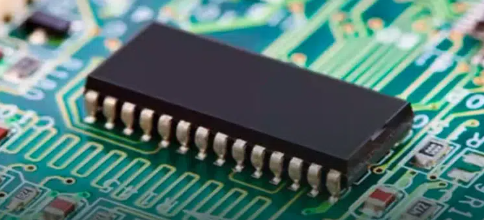Non-Traditional Chips Gaining Steam
Flexible hybrid electronics are beginning to roll out in the form of medical devices, wearable electronics and even near-field communications tags in retail, setting the stage for a whole new wave of circuit design, manufacturing and packaging that reaches well beyond traditional chips.
FHE devices begin with substrates made of ceramics, glass, plastic, polyimide, polymers, polysilicon, stainless steel, textiles, and other materials. They can be anything from flexible chips to conductive ink printed onto fabrics.
Academia is working with industry to develop these substrate materials. Arizona State University, Cal Poly, MIT, Northeastern University, Purdue University, Tokyo University, the University of Massachusetts at Lowell, and the University of Sheffield are among the institutions of higher learning involved in the field.
Researchers at the University of Glasgow’s Bendable Electronics and Sensing Technologies Group have developed an ultrathin four-inch silicon wafer that can be bent and flexed. Chips from such wafers, measuring 15 microns in thickness, could be attached to flexible substrates for use in flexible electronics.
Also helping to coordinate research and development in printed electronics and FHE are three organizations affiliated with SEMI – the FlexTech Alliance, the Nano-Bio Manufacturing Consortium, and NextFlex.
Brewer Science, Molex, and Thin Film Electronics (Thinfilm) are among the companies making products with flexible substrates. NXP Semiconductors and STMicroelectronics are fabricating flexible NFC tags encasing their silicon-based microchips.
FHE substrates vary greatly, said Dean Freeman, chief analyst at Freeman Technology and Market Advisors. “Anything from a silicon wafer — on it, you can use a flexible plastic substrate, which you can then print metal leads onto, and then you can either put silicon on top in a thinned-out form or do additional printing or screening onto that. You could also just use a flexible material, such as flex electronics does, and print directly on that.”
Polymers are particularly attractive for this kind of circuitry. “Molex has a large series of polymer substrates that they will print the leads on for you, and then you can attach either your regular-sized die to or you can thin it down to make it a little more flexible,” said Freeman. “Thinfilm uses a polymer substrate, for the most part, in their overall process. That’s the predominant material. Back in the dark ages, it used to have to be conductive a little bit, or be of a certain specific type. It still has to be of a certain specific material to absorb the material, but that’s not as critical as it used to be. The substrate doesn’t have to be conductive anymore. They’re depending now more upon the printing process to go ahead and take care of the electrical characteristics of the device. Thinfilm probably has the most popular and successful business from a printed electronics perspective. When you’re printing OLEDs on a flexible screen material, such as flexible quartz or glass that has been thinned way down, they’re printing OLEDs on the glass and not the polymer.”
Printed inductors can be made for use in MRI machines. Diageo is using flexible electronics to authenticate its Scotch and other alcoholic beverages. Craft beer makers can employ flexible electronics to protect the integrity of their products. There are applications in diabetes testing and pharmaceutical manufacturing, as well.
“The whole market is getting closer to reality,” Freeman says. “I don’t think substrates are a gating factor. We’re still looking for that killer app.”
Melissa Grupen-Shemansky, SEMI FlexTech’s CTO for flexible electronics and advanced packaging, brings an industry perspective to FHE R&D, having worked at Motorola’s Semiconductor Products Sector, Bell Laboratories, and Advanced Micro Devices/Spansion in her career.
“Substrate suppliers are all working to develop the most stable, flexible, and innovative technologies in each type. They know that every application demands tradeoffs when choosing a substrate,” she said. “There are tradeoffs in processing methods – primarily temperature, but also sheet-fed vs. roll-to-roll. There are tradeoffs in flexibility, too. Sometimes you want full flexibility, sometimes a little bit of flex is enough, such as the Samsung Galaxy S8 smartphones. And there are tradeoffs in electrical, thermal and mechanical properties, including determining stability when encapsulating or packaging. There also are tradeoffs in clarity, or transparency, which are useful in display applications; trade-offs when determining if the substrate will be multilayer or ‘smart’ by incorporating sensors (Purdue’s Birck Institute is doing a lot of characterization on this). And there are tradeoffs in throughput, costs, and process complexity. Some substrates lend themselves to roll-to-roll more than others. Overall, substrate characteristics must match the application. Evaluating the appropriate substrate is one part of the evaluation phase in creating a solution for any given application.”
Polyethylene terephthalate and polyethylene naphthalate are among the dominant materials in FHE substrates, Grupen-Shemansky noted. “PET, PEN and other polymers are used extensively for their low cost, flexibility, and transparency,” she says. “Stainless steel and other metal foils are being used in many of the IoT devices for their stability and easy-to-go web processing. Flexible ceramic is higher cost, but offers extreme stability even when exposed to harsh materials. Flexible glass has transparency and good stability. For textiles, knits, wovens, nonwovens, electrospun membranes, butyl rubber provide flexibility and low cost. And the classic copper flex, polyimide, is used in subtractive processing because it has excellent thermal properties.
Perhaps even more important, the supply chain is made up of well-established tooling companies and suppliers.
“All of these technologies compete on price and performance when application developers are doing their evaluations,” she added. “Many of them have not yet seen a killer application that could drive prices to match existing materials – or development to a perfect set of characteristics. Many would agree that it feels like we are on the cusp with the tremendous amount of application development going on. IoTapplications are progressing very nicely, but the price points that drive developers toward low-cost substrates are not yet in place. Integrators also seem to be making system portioning decisions based on what they know, such as copper flex. It is a well-known substrate, and moving away from it is risky. Flexible substrate developers are looking to give integrators more reason, whether that’s processing, price, or performance, to move away from copper flex. It seems the first may be textiles which have a clear performance advantage when it comes to medtech, performance garments, or fashion.
Justin Spitzer, Molex’s manager, global business development for flex circuits and printed electronics solutions, points to a number of trends in FHE.
“We are seeing some development of higher-temperature PET-type substrates, but they have not reached mass market penetration and the costs are still higher than standard PET,” he says, adding, “Stretchable substrates such as TPU are making inroads. Molex is working on qualifying them for reliability and production. Component attachment is on the future roadmap. The challenge is holding an alignment on product that can stretch. We are also seeing interest in paper substrates and fabrics.”
For now, “PET is still the main substrate of choice in FHE, outside of copper flex,” Spitzer says.
He continues, “Cost and environmental consciousness are the important driving factors. Additionally, from a construction perspective, flexibility and reduced height are considerations for wearable product and smart labels.”
On the topic of academic-industry collaboration, Spitzer says, “This is a very popular focus that we are seeing in the industry. As a result, there are new consortiums being created to address this development. We have collaborations with a few government entities and non-governmental groups to maintain awareness of market demands and to assist in bringing the technology to production.”
Market growth potential
IDTechEx forecasts that the market for conformable and stretchable electronics will enjoy growth over the next decade, reaching $600 million by 2027. The field will make use of conductive materials, conductive inks, e-textiles, and in-mold electronics technology. IME will be enabled by transparent conductive films.
Khasha Ghaffarzadeh and James Hayward of IDTechEx write, “Stretchable sensors are of course not limited to ink-based ones. Indeed, there are many other varieties. In the low strain end, we have conformable sensors that are commercialized. One example would be printed piezoresistive sensors. The sensors can conform to the topography of a patient’s tooth, to the contours of a person sleeping, or to the shape of a customer’s foot. In the high strain end, too, we are seeing increased commercial progress. Here, we have highly-stretchable resistive or capacitive sensors. These sensors will essentially extend the strain-sensing capability beyond the limitations of conventional gauges like metal foils.”
These are part of what IDTechEx calls the third wave of wearable sensors. “The first wave is characterized in long-established wearable products, such as hearing aids or GPS devices,” say Ghaffarzadeh and Hayward. “The second came from sensors adapted from another industry, such as inertial measurement units from smartphones. Finally, the third wave comes from ‘made-for-wearable’ sensors, developed with key properties of wearable devices in mind. This sector remains relatively small today, but as different wearable technology sectors begin to mature, this will become the largest sector within the next decade, accounting for around half of the total revenue from all wearable sensors.”
Much of the work in flexible substrates involves companies that already have experience with substrates. “That could be because many of the traditional materials suppliers are large. There are some universities doing characterization, such as Purdue’s Birck Institute and UMass Lowell,” said SEMI’s Grupen-Shemansky. “NextFlex, an independently operated SEMI-FlexTech organization, is looking to speed the development of FHE manufacturing processes. By gathering the best of the best technology and doing leading-edge development of process methodologies, a lot will be learned that will allow integrators to lower the development costs of some of the more promising FHE applications. FlexTech and the Nano-Bio Manufacturing Consortium (NBMC) are also funding projects in the prototype area.”
At the 2018FLEX conference in Monterey, Calif., there was a session entirely devoted to FHE substrates. Sean Garner, senior research associate at the Corning Research Center, spoke about Corning’s flexible Willow Glass material and other products in his presentation. High-quality glass substrate material for roll-to-roll manufacturing measures less than 200 microns in thickness, a width of 1.2 meters, and length of 100 meters.
“The flexible glass R2R ecosystem is growing,” Garner said. “Application reliability requires system-level optimization.” Corning worked with Applied Materials on conveyance for handling glass web at production width, he added.
Manuela Junghaehnel, group leader at the Fraunhofer Institute FEP, described “the road from sheet-to-sheet to roll-to-roll processing,” in cooperation with a number of industry partners, including Corning, which provided Willow Glass substrates measuring 600mm?. Glass substrates can be used in architectural, automotive, display, electronics, energy storage, photovoltaic, sensor, smart windows, and wearables applications, she said.
Scott Gordon, new business development manager for DuPont Teijin Films, noted that his company is being divested in the merger of Dow and DuPont. Indorama Ventures has agreed to acquire DuPont Teijin Films, with closing of the transaction expected in the second quarter of 2018. DuPont Teijin Films, a joint venture of DuPont and Teijin Ltd., produces biaxially-oriented PET and PEN films.
John Olenick is president of Buffalo, N.Y.-based ENrG Inc., which licenses Corning’s thin-film flexible ceramic technology. The company is collaborating with ITN Energy Systems through funding from the FlexTech Alliance, he said. ENrG is also working with the Holst Centre, the University of Houston, Novasentis, and the University of Buffalo, among other parties, on a variety of projects.
The final presentation was by Radu Reit, chief technology officer of Ares Materials, a spinout from the University of Texas at Dallas. It offers the Pylux polysulfide elastomer platform for flexible and stretchable electronics. “Smartphones are moving from glass-based displays to plastic-based displays,” he observed. “We are on the same level as glass.”
Conclusion
A new generation of electronics is on the way. There will be conformable, flexible, and stretchable gadgets, ranging from smartphones to computer displays, and components for autonomous vehicles and other applications.
Enabling this transition will be a bevy of substrate materials, not confined to silicon and other traditional semiconducting materials. Flexibility won’t take over everything, but it certainly will enable new applications and pave the way electronics in entirely new markets.
在线留言询价

Packaging Chips For Cars
- 一周热料
- 紧缺物料秒杀
| 型号 | 品牌 | 询价 |
|---|---|---|
| MC33074DR2G | onsemi | |
| BD71847AMWV-E2 | ROHM Semiconductor | |
| CDZVT2R20B | ROHM Semiconductor | |
| TL431ACLPR | Texas Instruments | |
| RB751G-40T2R | ROHM Semiconductor |
| 型号 | 品牌 | 抢购 |
|---|---|---|
| BU33JA2MNVX-CTL | ROHM Semiconductor | |
| IPZ40N04S5L4R8ATMA1 | Infineon Technologies | |
| TPS63050YFFR | Texas Instruments | |
| BP3621 | ROHM Semiconductor | |
| ESR03EZPJ151 | ROHM Semiconductor | |
| STM32F429IGT6 | STMicroelectronics |
- 周排行榜
- 月排行榜
AMEYA360公众号二维码
识别二维码,即可关注



























